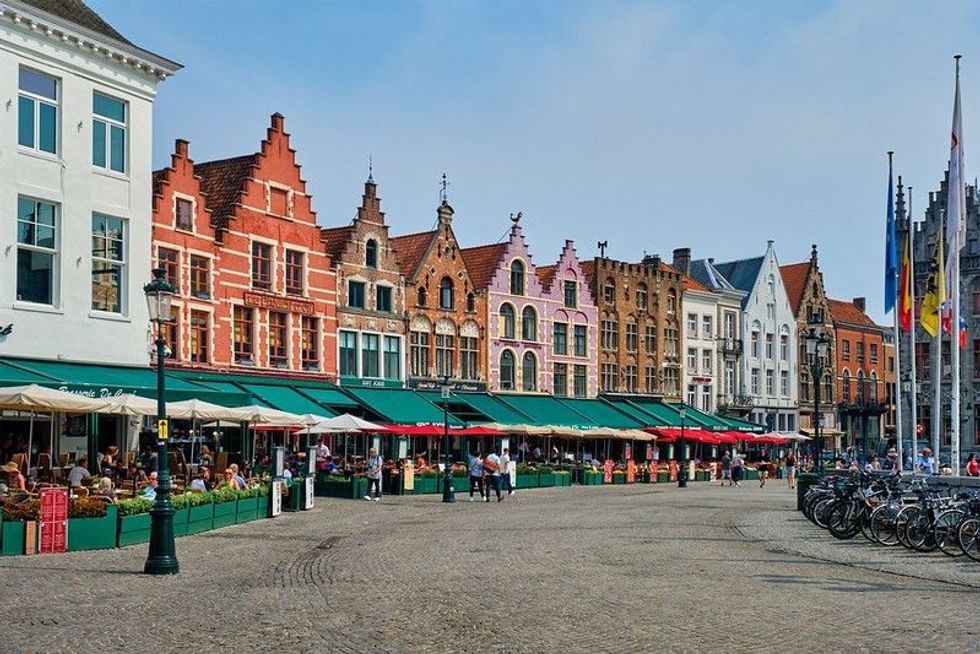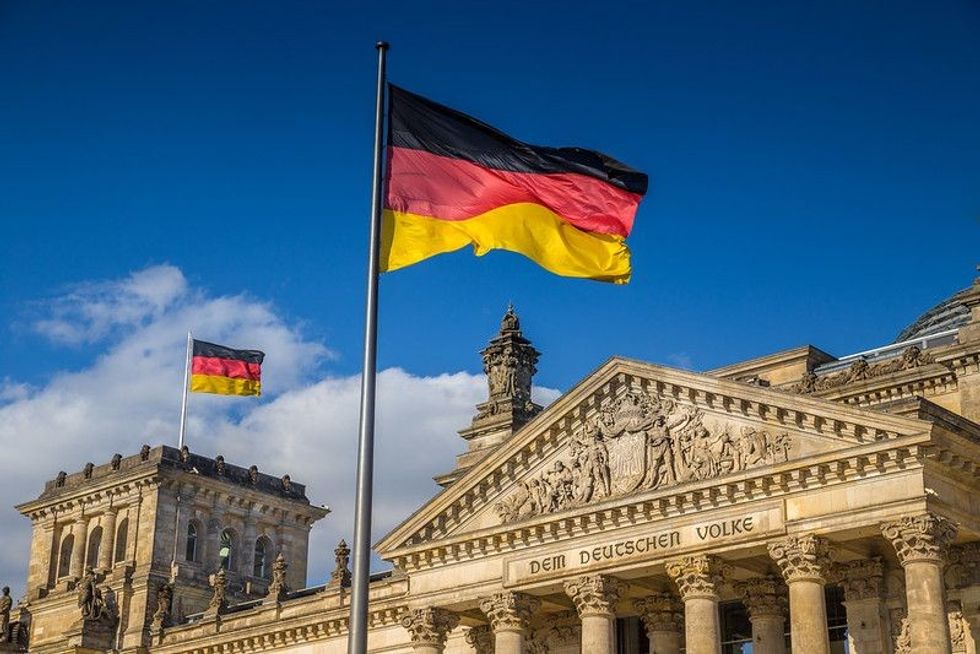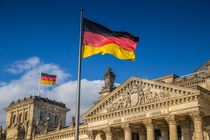100 German City Names To Inspire Your World Building

The five best known, major cities in Germany are Berlin, Hamburg, Munich (München), Cologne (Köln) and Frankfurt.
But, these main five cities aside, there are plenty more interesting German cities. From Schleswig-Holstein to Düsseldorf, there are so many amazing cities to learn about!
Did you know that most states in Germany are called Land? In plural they are called Länder. If you are looking for German city names for storytelling or worldbuilding, we can help you. We have put together this list of 100 German city names that can inspire you.
And if you like this article you can also check out these underwater city names and these Russian city names.
East German Cities

Eastern Germany can be described as the wellspring of voyagers who are eager to learn about the history, workmanship and design of the country. The rich urban architecture is something the nation displays with pride. We have compiled a list of cities from Eastern Germany.
1. Altenburg, is a Saxony duchy known for its food industries and engineering industries.
2. Bautzen, is a hilltop town situated on the bank of the River Spree in Saxony.
3. Chemnitz, is a city in East Central Germany in Saxony that is famous for the Karl Marx Monument.
4. Dessau, is known for architecture and in location in the Saxony-Anhalt region.
5. Dresden, is acclaimed for its fortune of craftsmanship and design.
6. Düsseldorf, is the most populous state in Saxony and is known for structures such as the St. Lambertus Church and Schlossturm Castle Tower.
7. Erlangen, is the seat of the administrative area Erlangen-Höchstadt, and it is the tiniest of the eight metropolitan networks in Bavaria.
8. Eberswalde, lies in the Thorn-Eberswalder icy valley in Saxony, around 30 miles (50 km) upper east of Berlin.
9. Erfurt, is a 1,200-year-old city and the state capital of Thuringia in Saxony. It was in the Augustinian Monastery in Erfurt that Martin Luther became a priest in 1505.
10. Eisenhüttenstadt, the name was changed to Eisenhüttenstadt (meaning "ironworks city") to mirror its modern nature.
11. Görlitz, is known for its Baroque, Renaissance and Gothic architecture which can be seen in St Peter and Paul's Church, St. Marienthal Abbey and Fat Tower.
12. Frankfurt, is a financial center of Germany and the home to the European Central Bank. It's also the home of famous writer Johann Wolfgang von Goethe.
13. Flensburg, is known for its marine post in Schleswig-Holstein. Near the shipyard exhibition, Museumswerft shows repeated eminent ships and hosts boatbuilding classes.
14. Göttingen, is known for the Old Botanical Garden which has a combination of restorative plants and an arboretum.
15. Gütersloh, is an acclaimed city in North Rhine-Westphalia, Germany. This city in North Rhine-Westphalia is the administrative district of Detmold.
16. Hanau, is a significant town in the Frankfurt am Main region.
17. Heilbronn, is known for its Town Hall façade with 16th century galactic clock.
18. Gera, is the third largest city in Thuringia, Saxony. It was founded in the late 13th century.
19. Halle, was a Saxony-Anhalt Duchy loaded with attractions like Castle Giebichenstein and Moritzburg and Halloren Chocolate Factory .
20. Leipzig, the notable city of Leipzig is fairly uncelebrated, yet can be named as one of the most energizing urban areas in Germany.
21. Karl-Marx-Stadt, also known as Chemnitz, is a city that survived World War II.
22. Magdeburg, is known as the green capital of Saxony-Anhalt.
23. Potsdam, is known for magnificent palaces, tranquil lakes and parks, and rich European history.
24. Saxony-Anhalt, a part of Eastern Germany and was formerly a duchy in Saxony.
25. Weimar, was the home of some of the greatest figures like Martin Luther, Cranach, Bach, Goethe, Schiller and Nietzsche as well as the Bauhaus Movement.
26. Zeitz, is a town in Saxony-Anhalt and is known for March of Zeitz.
West German Cities

Western Germany has something for everybody: urban communities, immaculate towns, old urban areas and beautiful villages.
27. Aachen, a famous spa city that attracts hundreds of travelers with its Roman architecture is a part of the North Rhine-Westphalia area.
28. Bacharach, is known for the Rhine Castle Cruise in the North Rhine-Westphalia area.
29. Bernkastel-Kues Bernkastel, is a place for wine lovers. The Mosel Wein Museum is the home where you can learn all about the history of wine production.
30. Boppard, is a quintessential city in the Rhineland-Palatinate region known for cobbled streets, an old château, grape plantations and half-wooden structures.
31. Bottrop, is the famous industrial region in North Rhine-Westphalia.
32. Cologne, is a western city in North Rhine-Westphalia. It is known for its generally energizing atmosphere. It is a UNESCO-recorded city.
33. Ingolstadt, it is known for the Audi Forum and its display of excellent vehicles.
34. Iserlohn, is known for its metalworking. It is a popular city in the Rhineland-Palatinate region.
35. Jena, is in Lower Saxony and is known for the Optical Museum.
36. Kaiserslautern, is known for the Palatinate Forest in the Rhineland-Palatinate region.
37. Koblenz, lies in the conjunction of the two rivers: Moselle and Rhine, in the Rhineland-Palatinate region.
38. Lünen, is found Lower Saxony. This Lower Saxony city is known for its rail junction, port and former coal-mining center.
39. Marl, is the oldest mining city in North Rhine-Westphalia.
40. Mainz, is known for Romanesque Mainz Cathedral, St. Augustine's Church and St. Stephen's Church. It is one of the most populated regions in the Rhineland-Palatinate region.
41. Marburg, is the inspiration behind The Brothers Grimm's fantasies. It is known for its palace, entryways, houses and the Lahn River in Lower Saxony .
42. Minden, is the town in Lower Saxony known as the historic political center of Germany.
43. Moers, this city is located on the western bank of the Rhine and Wesel in Lower Saxony.
44. Offenbach, this town in Lower Saxony is known for Rumpenheim Palace and its park. The park of this Lower Saxony city was a renowned goal for rulers in the 19th century.
45. Pforzheim, is a city in the Baden-Württemberg region known for its pearls and watch industries.
46. Ratingen, is a thriving city in North Rhine Westphalia where various worldwide PC brands and creative businesses are based.
47. Reutlingen, is the home of the world's best textile industry and Reutlingen university. It has the most secure street in the Baden-Württemberg region.
48. Recklinghausen, is the 60th greatest city in Germany and the 22nd greatest city in the North Rhine-Westphalia region.
49. Trier, is one of the eight UNESCO locations in the Rhineland-Palatinate region that dates back to Roman times.
50. Velbert, is located in Mettmann, in the North Rhine-Westphalia region of Germany, and is known for the production of locks and keys.
South German Cities
Southern Germany is an interesting mix of traditional, beautiful towns made immaculate by time, urban architecture and quintessential middle age towns.
51. Aalen, started as part of Roman fortification and turned into a free city in 1360, this city was seriously harmed by fire in 1634.
52. Amberg, is located on the Vils River, this town was an industrial center until the 16th century.
53. Bruchsal, lies along the Saalbach tributary of the Rhine.
54. Bamberg, this city extends to more than seven slopes, looking down at the River Regnitz.
55. Baden-Württemberg, Baden-Württemberg is a state in southwest Germany surrounded by France and Switzerland. In Germany, the prefix "bad-" is used for spa towns, as seen in the name of the city of Baden-Württemberg.
56. Esslingen, lies along the Neckar River in Baden-Württemberg. It was first referenced in 777 as Cella and in 866 as Hetsilinga.
57. Freiburg im Breisgau, the college town of Freiburg im Breisgau is known for its proximity to the Black Forest.
58. Füssen, is known for Neuschwanstein Castle and its violin production industry.
59. Garmisch, sits beside the grand Bavarian Alps and is speckled with reflected elevated lakes.
60. Göppingen, is known for the Gothic Oberhofen Church and the former Ducal Palace.
61. Hechingen, is known for its rail junction and manufactures machinery, textiles and wood products.
62. Heidelberg, the college town of Heidelberg is a social and scholarly center point of Germany. It is also the location of the 13th century Heidelberg Castle.
63. Karlsruhe, is the major hub for science and technology and is located in the Rhine in Baden-Württemberg.
64. Lindau, is a fantastic city on the shore of Lake Constance.
65. Ludwigsburg, is known for three palaces. It is one of the beautiful towns in Baden-Württemberg.
66. Munich, is among the most mainstream urban areas in Germany and has something for everybody. Munich is located at the River Isar in the south of Bavaria.
67. Regensburg, is home to a UNESCO World Heritage Site, it is surrounded by the River Danube on two sides, has more than 1,000 landmarks and dates back to Roman civilization.
68. Rhineland-Palatinate, is located on the southwest border of Germany and is surrounded by France, Belgium and Luxembourg on either side.
69. Rothenburg ob der Tauber, the little town of Rothenburg ob der Tauber has been awarded the title of the prettiest city in Bavaria.
70. Stuttgart, is a beautifully designed city in Baden-Württemberg known for local craftsmanship and its car galleries.
71. Tübingen, is located on the banks of Neckar River and falls at the intersection of the Ammer and Steinlach waterways, south of Stuttgart.
72. Ulm, lies on the left bank of the Danube River and falls at the intersection of the Iller and the Blau in the Baden-Württemberg region.
73. Villingen-Schwenningen, is situated among the apexes and coniferous backwoods of the eastern Black Forest.
74. Wittenburg, this city is in Saxony-Anhalt is known for its coal mines. It is a populated city in Saxony-Anhalt.
75. Würzburg, is a city in Germany's Bavaria area. It's known for greenery, flora and fauna, and particularly the 18th century Residenz.
North German Cities
Northern Germany draws in vacationers with its stunning variety. You will find cutting edge urban communities with a rich history, similar to Berlin, Munich and Hamburg, here. The Ruhr area situated in the north, is also the largest urban area in Germany.
76. Berlin, Germany's capital city is known for its social and scholarly centers, workmanship and history. Berlin is home to the world famous Berlin Opera and Berlin Philharmonic Orchestra
77. Binz, the elegant hotel town is known for its fine white sand, a beautiful promenade and architecture.
78. Bergisch Gladbach, was founded in 12th century and is located in the Region of North Rhine-Westphalia.
79. Bremerhaven, is the home to the German Maritime Museum.
80. Fürth, this is known as the spiritual center for Franconia's Jewish community.
81. Harz Mountains, lies between the Elbe and the Weser rivers and is known for its narrow V-shaped valleys.
82. Hamburg, Hamburg is one of a kind city, where ancient and modern architecture is mixed together.
83. Heligoland, is known for its remote location.
84. Hildesheim, is famous for its sanctuaries and UNESCO-recorded churches, Mariendom and St. Michael's.
85. Leverkusen, has only 161, 000 inhabitants and is known for as the home of medication company Bayer.
86. Lübeck, dates back to the Middle Ages and is one of the UNESCO World Heritage Sites in Schleswig-Holstein.
87. Ludwigshafen, is in the Rhineland-Palatinate region and is the home of previous German chancellor Helmut Kohl.
88. Mecklenburg-Vorpommern, is the home of the old steam train Rasender Roland.
89. Neuss, is a city in the Rhein-Kreis Neuss territory and is known for its Roman architecture.
90. Rostock, is known for its waterways and the architecture of its churches, St. Mary's, Nikolai and St. Petri.
91. Rugen Island, is located in the Baltic Sea region and is known for its flawless seashores.
92. Salzgitter, it is a modern city with standing for its steel creation.
93. Schleswig-Holstein, is known for the rebuilt Gothic-style Lübeck Cathedral and the city gate Holstentor. This red brick gate was built in the 1400s.
94. Siegen, is nicknamed 'Rubens City' after its praised inhabitant, the Flemish painter Peter Paul Rubens.
95. Stralsund, is known for its block Gothic design.
96. Sylt, is known as The Queen of North Sea and has been named as a UNESCO-recorded city in the Wadden Sea region.
97. Wernigerode, is a gem of the Harz Mountains and is one of the most interesting towns in the entirety of Germany.
98. Wismar, the UNESCO-recorded city of Wismar is protected for its aristocratic houses.
99. Wilhelmshaven, is a town located in Lower Saxony, Germany.
100. Wolfsburg, is known for being the location of the headquarters for Volkswagen. It is the most populated city in Lower Saxony.
Kidadl has lots of great names articles to inspire you. If you liked our suggestions for German city names then why not take a look at something different like these German names for dogs, or these uncommon German last names?
Article image credit: Dmitry Rukhlenko / Shutterstock.com
We Want Your Photos!
More for You
Bachelor of Arts specializing in French with Film Studies, Bachelor of Arts (Year Abroad) specializing in Literature, History, Language, Media, and Art

Georgia StoneBachelor of Arts specializing in French with Film Studies, Bachelor of Arts (Year Abroad) specializing in Literature, History, Language, Media, and Art
Georgia is an experienced Content Manager with a degree in French and Film Studies from King's College London and Bachelors degree from Université Paris-Sorbonne. Her passion for exploring the world and experiencing different cultures was sparked during her childhood in Switzerland and her year abroad in Paris. In her spare time, Georgia enjoys using London's excellent travel connections to explore further afield.
Disclaimer
1) Kidadl is independent and to make our service free to you the reader we are supported by advertising. We hope you love our recommendations for products and services! What we suggest is selected independently by the Kidadl team. If you purchase using the Buy Now button we may earn a small commission. This does not influence our choices. Prices are correct and items are available at the time the article was published but we cannot guarantee that on the time of reading. Please note that Kidadl is a participant in the Amazon Services LLC Associates Program, an affiliate advertising program designed to provide a means for sites to earn advertising fees by advertising and linking to Amazon. We also link to other websites, but are not responsible for their content.
2) At Kidadl, we strive to recommend the very best activities and events. We will always aim to give you accurate information at the date of publication - however, information does change, so it’s important you do your own research, double-check and make the decision that is right for your family. We recognise that not all activities and ideas are appropriate for all children and families or in all circumstances. Our recommended activities are based on age but these are a guide. We recommend that these ideas are used as inspiration, that ideas are undertaken with appropriate adult supervision, and that each adult uses their own discretion and knowledge of their children to consider the safety and suitability. Kidadl cannot accept liability for the execution of these ideas, and parental supervision is advised at all times, as safety is paramount. Anyone using the information provided by Kidadl does so at their own risk and we can not accept liability if things go wrong.
3) Because we are an educational resource, we have quotes and facts about a range of historical and modern figures. We do not endorse the actions of or rhetoric of all the people included in these collections, but we think they are important for growing minds to learn about under the guidance of parents or guardians.







